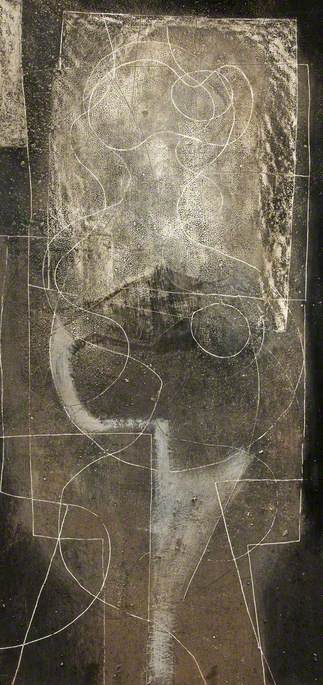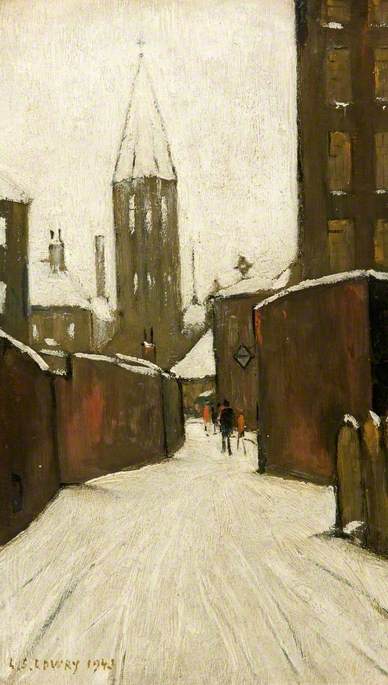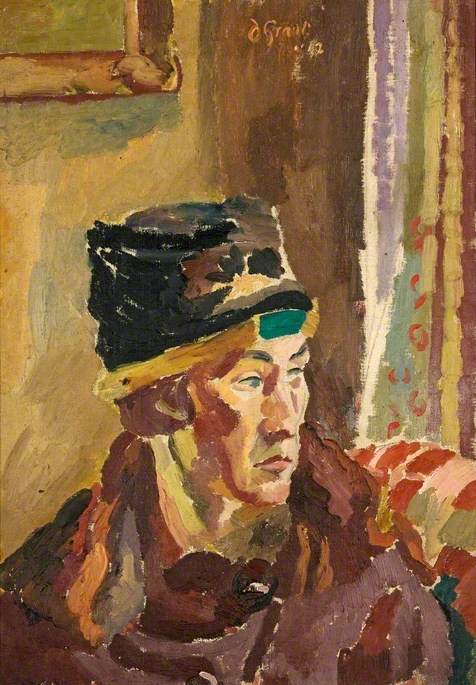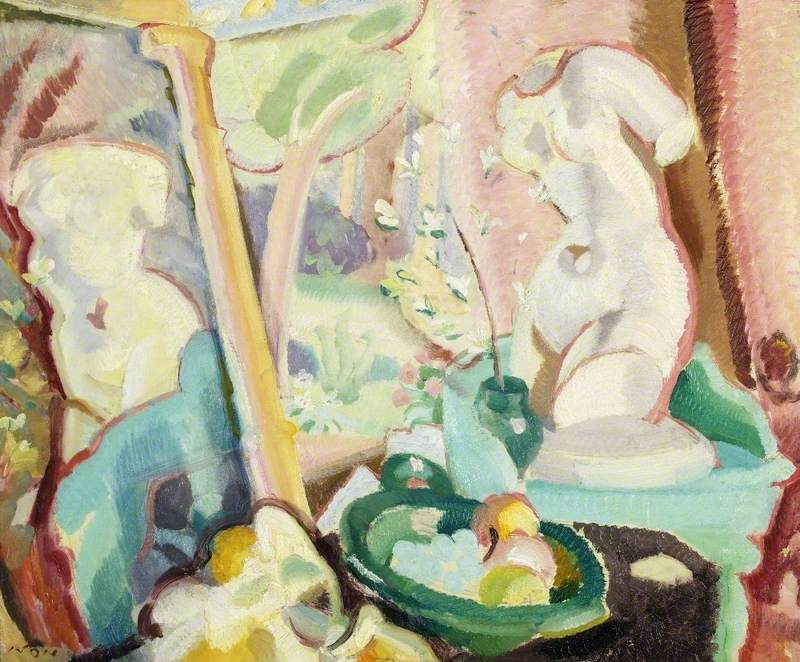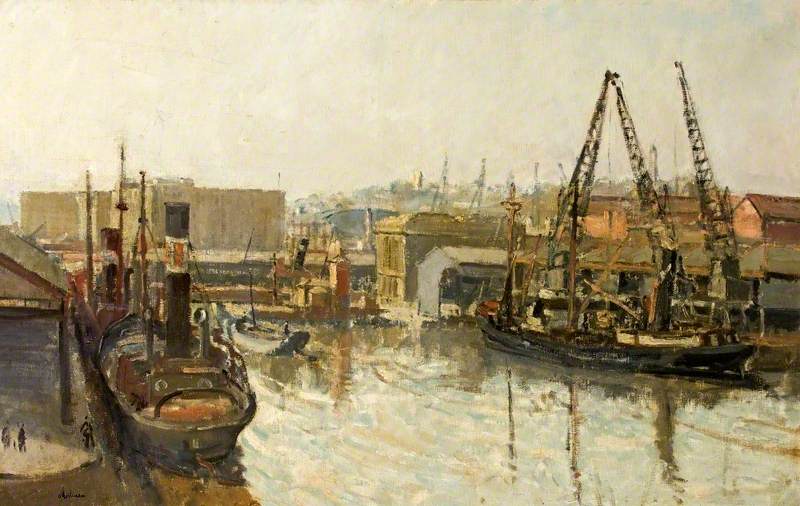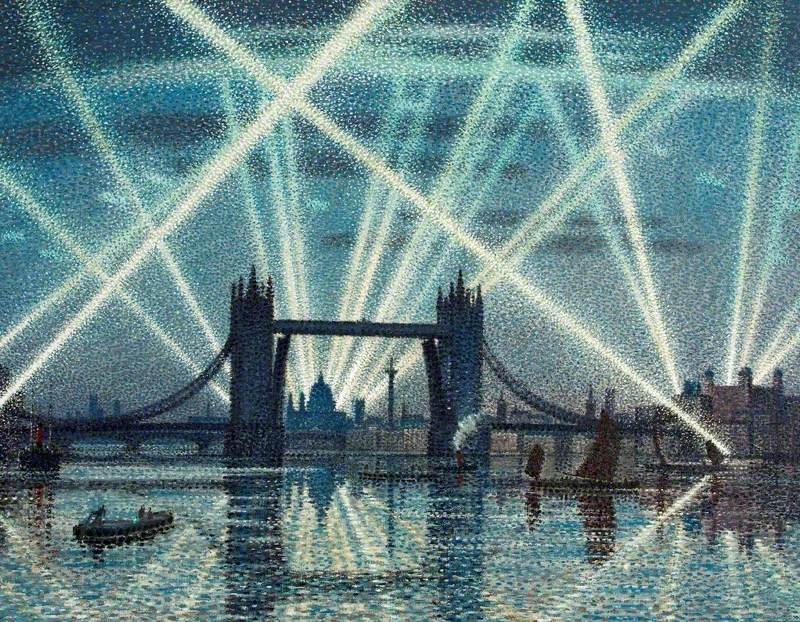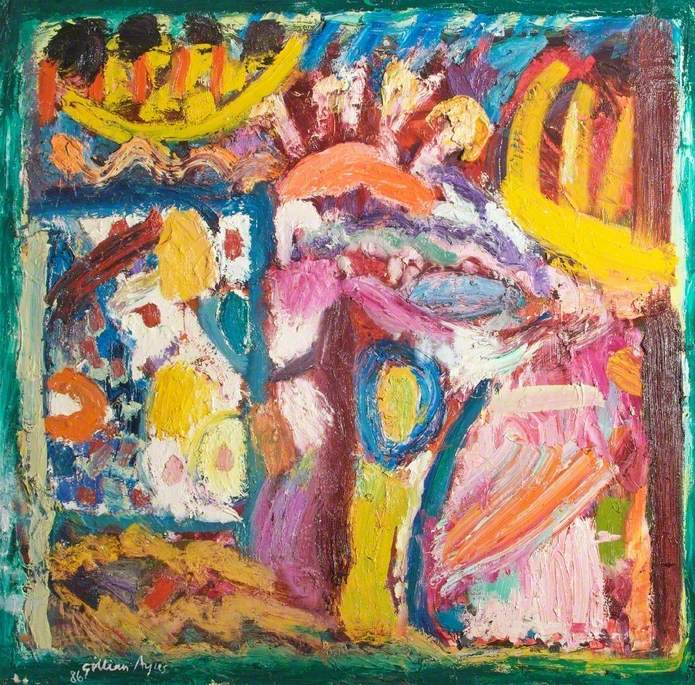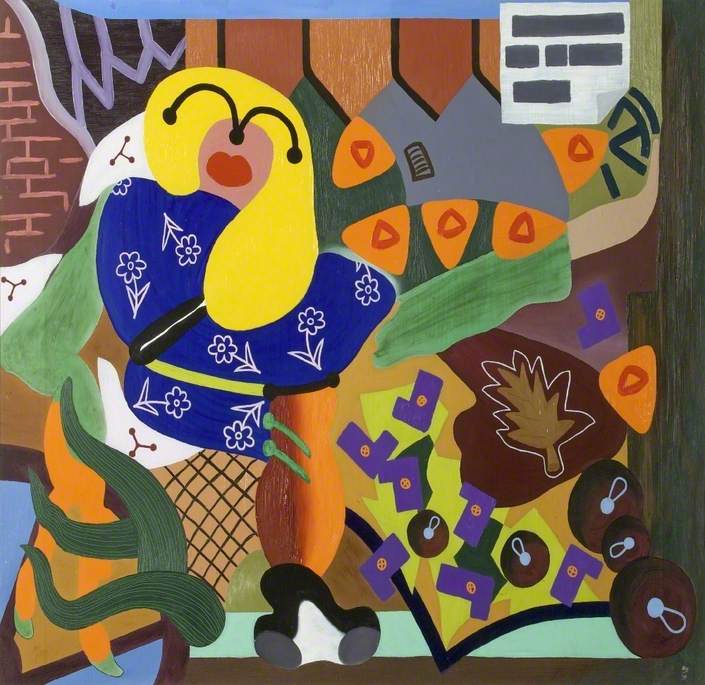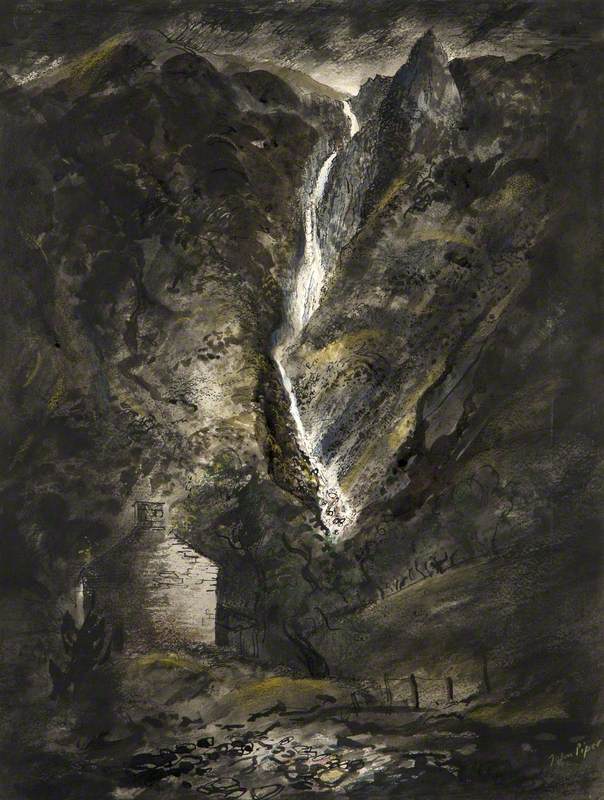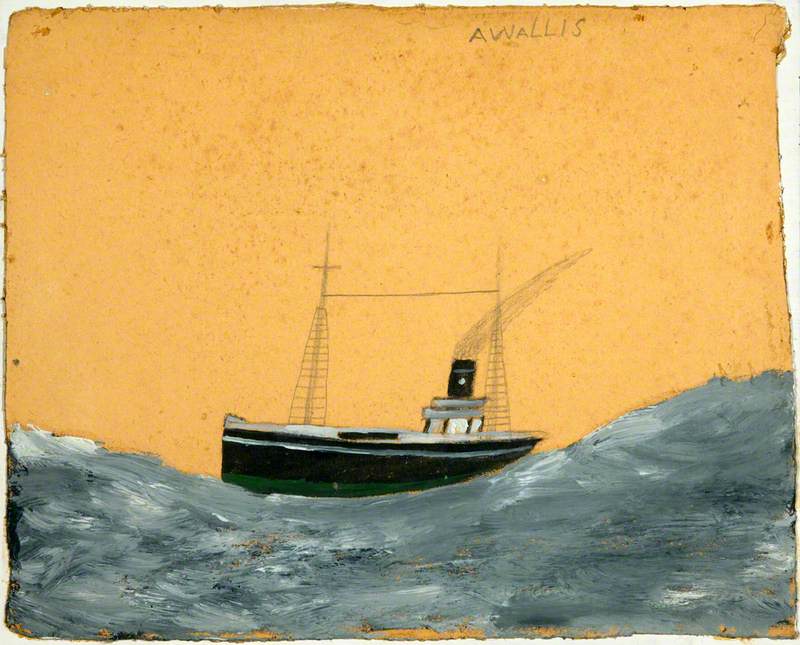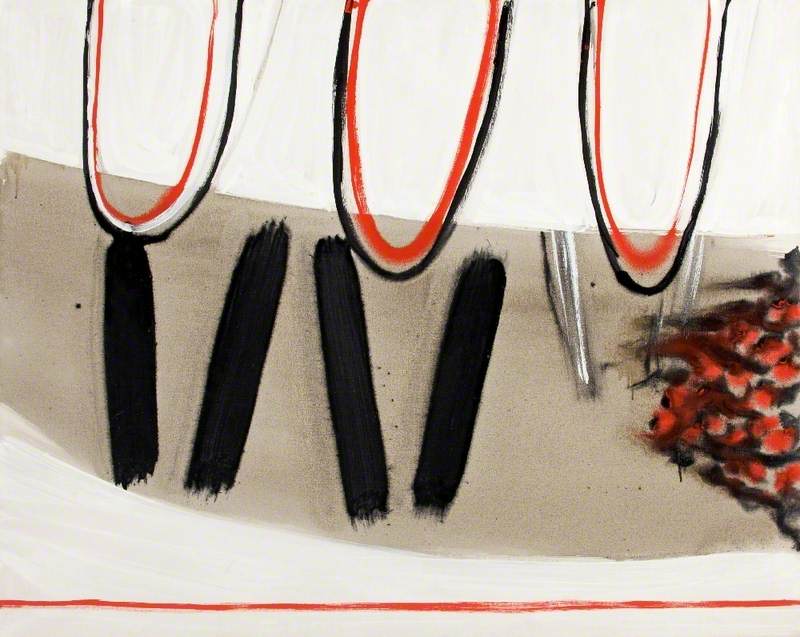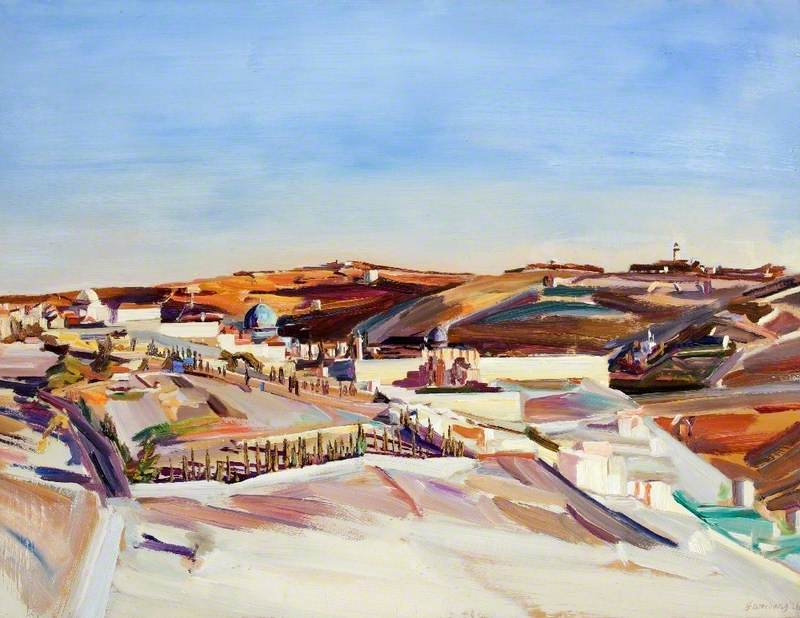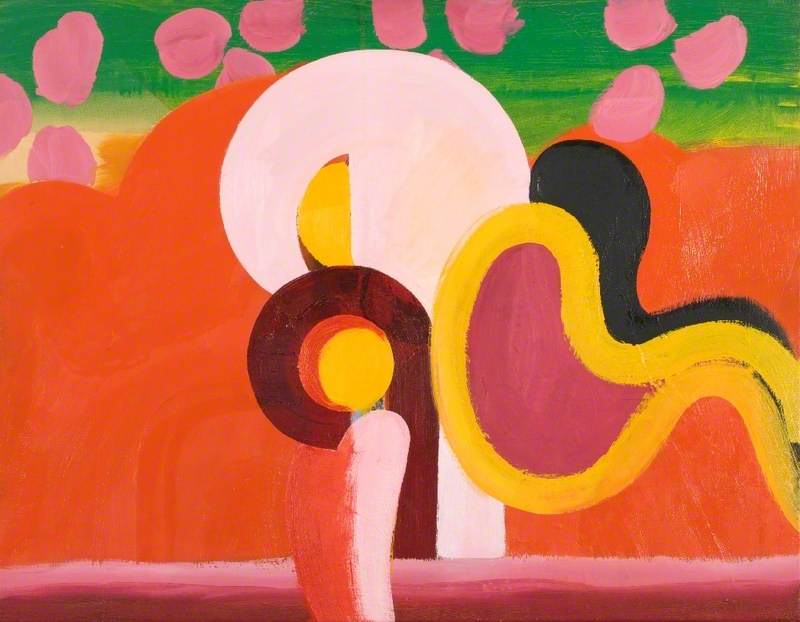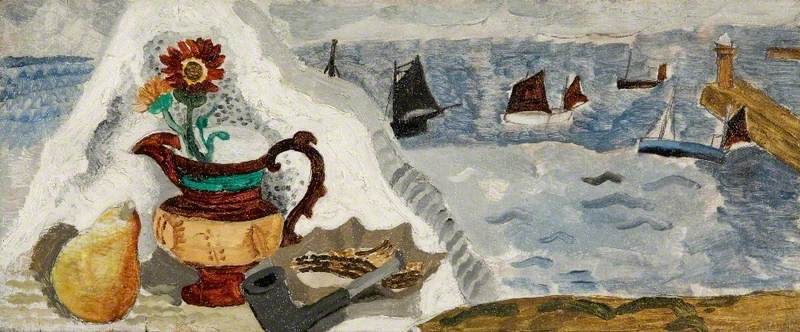This virtual exhibition is curated by the Friends of Swindon Museum and Art Gallery, and shines a spotlight on some of the most significant artists represented in Swindon’s collection of modern British art. Selected artworks span the Twentieth Century and include work from defining groups and movements, such as the Bloomsbury Group, the St Ives School and the School of London. ‘Big Hitters’ also showcases pieces by important contemporary painters Christopher le Brun, Eileen Cooper and Maggi Hambling, as well as treasured paintings in the collection by Gillian Ayres, David Bomberg, L.S. Lowry and many more.
-
1933 (composition in black and white)
1933 (composition in black and white) 1933This important painting is an example of pure abstraction. A simple tonal palette has been scraped and incised to reveal the white underpainting. It is a work that combines Nicholson’s knowledge of painting and sculpture. Straight and curved lines suggest the shape of a figure or musical instrument, but the influences remain enigmatic.
Nicholson was an influential figure in British art. In St Ives, he and Hepworth were at the heart of an artistic community, which included Christopher Wood, Borlase Smart and Alfred Wallis. He was a key figure in the development of abstract art both in Britain and internationally.
Ben Nicholson (1894–1982)
Oil & gesso on board
H 112 x W 53 cm
Museum & Art Swindon
-
Play Dead II
Play Dead II 1995–1997Eileen Cooper is an artist concerned with the relationships between people. In her drawings and paintings, she explores human dynamics from her perspective as a female artist. Since the 1980s, her art has embraced figurative depictions of stories and personal interactions. It is both universal and deeply rooted in her lived experience as an artist, mother and wife.
Eileen Cooper (b.1953)
Oil on canvas
H 68.5 x W 91.5 cm
Museum & Art Swindon
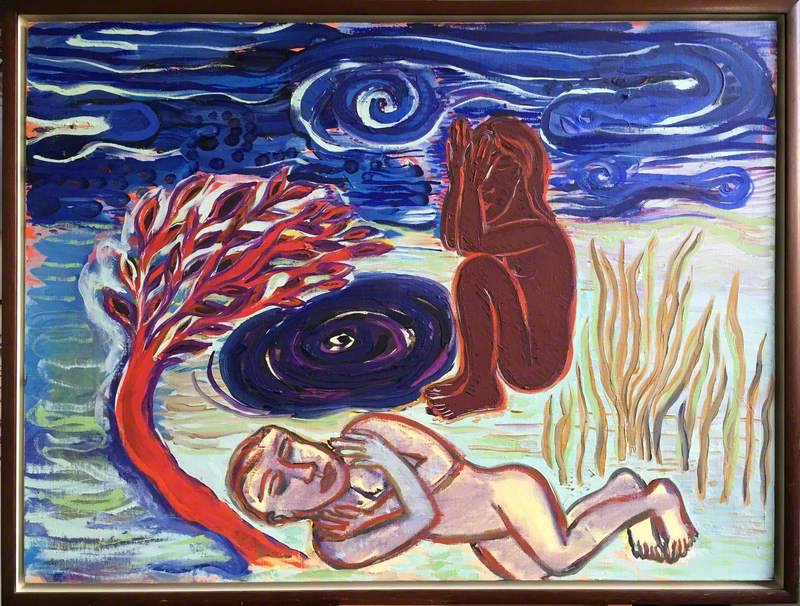 © Eileen Cooper / Bridgeman Images. Image credit: Museum & Art Swindon
© Eileen Cooper / Bridgeman Images. Image credit: Museum & Art Swindon
-
Winter in Pendlebury, Manchester
Winter in Pendlebury, Manchester 1943Lowry is one of Britain’s best loved artists. His paintings show everyday life in the north of England against a backdrop of factories, terraced houses and coal mines.
Lowry is famous for his ‘Matchstick Men’, the thin dark figures that fill his paintings. They capture the working people hurrying to and from factories and offices, or enjoying processions, fairs and football matches.
Lowry spent most of his life working as an office clerk, painting and studying art in his free time. His art was discovered in 1939, when Lowry was 52. His first exhibition followed soon after. The Swindon Collection of Modern British Art contains two paintings by Lowry.
Laurence Stephen Lowry (1887–1976)
Oil on panel
H 42.2 x W 22.8 cm
Museum & Art Swindon
-
Seated Model
Seated Model c.1915–1916This portrait of an unknown woman is striking for its breadth and freedom of handling. The use of change of hue rather than of tone for the shadows is a legacy from the Impressionists but the scrawly loopy brushstrokes which sweep over the canvas in all directions are characteristic of Grant, especially the caligraphic definition of the shadow on the sitter's right cheek. The painter's delight in his medium contrasts with the sitter's glum expression.
Duncan Grant (1885–1978)
Oil on board
H 57.5 x W 40 cm
Museum & Art Swindon
-
Spring in Eden
Spring in Eden 1925Hitchens described Spring in Eden as "frankly a still life group, making use of my studio properties – a very large mirror – daffodils in front – a bowl of fruit – the mirror reflecting a cast of a famous sculpture by Legros which I used many times". Like most of his generation he was impressed by Cezanne, but this decorative composition also shows the influence of the Bloomsbury painters especially in its use of outline and the fresh light colours.
Ivon Hitchens (1893–1979)
Oil on canvas
H 49 x W 59.5 cm
Museum & Art Swindon
-
The Port of Bristol
The Port of Bristol 1938This painting is Lord Methuen’s painting of the Port of Bristol which was bought from Leicester Galleries and given to Swindon in 1944.
The artist, Paul Ayshford, was the Fourth Lord Methuen, and who was not only an accomplished painter but also undertook a lot of public work to raise awareness of the arts and of national heritage.
The Port of Bristol painting was completed in 1938, and depicts the area of the Port of Bristol known as The Floating Harbour – you can see the building that is now the Arnolfini Gallery to the immediate left of the cranes. Nearly all the other buildings were bombed during the Second World War, and the area is now a key Bristol tourist attraction.
Paul Ayshford Methuen (1886–1974)
Oil on canvas
H 64.3 x W 102 cm
Museum & Art Swindon
-
Hyperion
Hyperion 1982Christopher Le Brun is a painter, sculptor and printmaker, whose stunning piece ‘Hyperion’ entered Swindon’s collection in 1982. The eight foot high canvas fuses the artist’s painterly technique with classical mythology, to create a monumental painting of the winged horse Pegasus. Since the piece was acquired by Swindon thirty-five years ago Le Brun has had a rich career, exhibiting work and entering collections throughout the UK, Europe and America.
Christopher Le Brun (b.1951)
Oil on canvas
H 249 x W 214 cm
Museum & Art Swindon
-
Tower Bridge, London: A War-Time Nocturne
Tower Bridge, London: A War-Time NocturneThis painting shows Tower Bridge during the middle of the Second World War. The bridge is open and its tall towers are silhouetted by the white beams of search lights and by exploding anti-aircraft shells. In the foreground, barges cross the Thames.
The painting is subtitled ‘A War-Time Nocturne’ in reference to the artist James Abbott McNeill Whistler’s series of Thames paintings. It encourages us to see something atmospheric in the work. The searchlights guide our eye to the Tower of London and St Paul’s Cathedral, symbols of fortress-like strength and spirituality. Although war may be raging, this painting celebrates London’s stunning architecture and resilience.
Claude Francis Barry (1883–1970)
Oil on canvas
H 73 x W 94.5 cm
Museum & Art Swindon
-
Self Portrait with Juliet
Self Portrait with Juliet 1979This painting is a double portrait of John Bellany with his second wife, the artist Juliet Lister. Two figures stand at a large canvas, Bellany holding an artist’s palette in one hand, Juliet resting her hand on her husband’s shoulder. In the foreground is a model ship with the word ‘Mizpah’ painted on its hull.
Although Bellany said that he did not like to interpret his art because “words can demean paintings”, he did speak about this work. It is, he wrote, a “sad” painting, “about two people holding on to each other, one ill, having been in hospital, and the other trying to keep her going”.
John Bellany (1942–2013)
Oil on canvas
H 165 x W 106.7 cm
Museum & Art Swindon
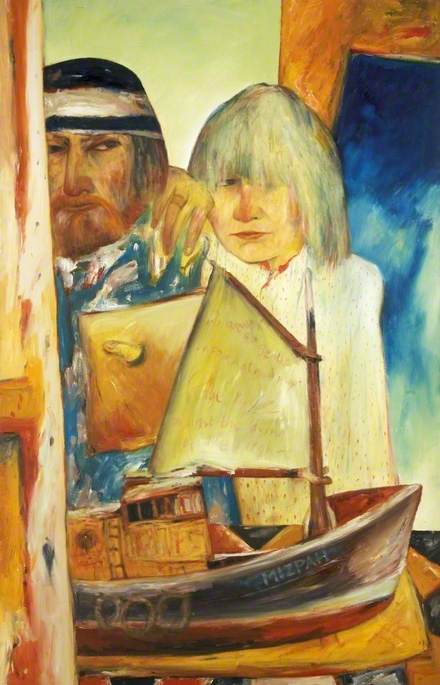 © the artist's estate / Bridgeman Images. Image credit: Museum & Art Swindon
© the artist's estate / Bridgeman Images. Image credit: Museum & Art Swindon
-
Nude with Poppies
Nude with Poppies 1916Bell was inspired by travel and by Byzantine and Post-Impressionist art, which she discovered through her friend, the critic and artist Roger Fry. After visiting his 1910 exhibition of Van Gogh and Pablo Picasso, Bell described feeling, “sudden liberation and encouragement to feel for oneself”. She began experimenting with simplified forms and vivid colours
This painting is illustrated with “a woman asleep… with poppies and waves. All very symbolical”, as Bell wrote to Fry. It is a simplified work, with a sinuous female form and two oversized red opium poppies above. The flowing lines and poppy motif give the work a sleepy, peaceful atmosphere.
Vanessa Bell (1879–1961)
Oil on canvas
H 23.4 x W 42.4 cm
Museum & Art Swindon
-
Florestan
Florestan 1986Ayres was interested in the materiality and ‘silent communication’ of painting. She did not enjoy talking about her work or its relationship to that of her contemporaries. She spoke of her love of classical music and cites Rubens and Titian as influences.
Speaking of Florestan, Ayres said “I want the ruddy things to be alive” and that she hopes her paintings “give delight”. A vast selection of brushes, paint shades and techniques have been used. Florestan is indeed a lively, joyful painting, filled with bright colours and thick texture. The scale is large, almost overwhelming the viewer with light and colour.
Gillian Ayres (1930–2018)
Oil on canvas
H 137.5 x W 138.5 cm
Museum & Art Swindon
-
Girl Selling Flowers
Girl Selling Flowers 1946Morris was born in Swindon and is a broadcaster, filmmaker, zoologist, anthropologist, author and artist. This colourful, abstract painting shows the actress Diana Dors, also born in Swindon, who was Morris’s girlfriend at the time.
Desmond Morris is the Patron of the Friends of Swindon Museum and Art Gallery, His great-grandfather founded the Swindon Advertiser.
Desmond Morris (b.1928)
Oil on board
H 73 x W 88 cm
Museum & Art Swindon
-
Pistyll Maes-Glasau
Pistyll Maes-Glasau 1940Pistyll Maes-Glasau is a waterfall in Snowdonia, an area Piper regularly visited between the 1940 and 1950s. This work shows his intense observation of both the physical shape of the landscape, as well as the dramatic atmosphere created by the weather and falling water. Despite the dark colours, close observation show hints or red and green underpainting, which gives the finished work a lightness.
John Piper (1903–1992)
Chalk, charcoal & gouache on paper
H 50.2 x W 37.5 cm
Museum & Art Swindon
-
Descent of the Bull's Head
Descent of the Bull's Head 1985Hambling first saw a bull fight in 1977 in Madrid and it had a great impact on her. The subject matter, to paraphrase her own words, bubbled away quietly inside her, until she decided to pursue it.
The Descent of the Bull’s head, depicts four stages of the bull transforming from a powerful animal, to being tormented, struck and eventually falling to the ground. It is not a particularly cheerful scene, but of course that is the point, as the focus is on the brutish side of human nature.
Maggi Hambling (b.1945)
Oil on cotton duck
H 160 x W 122.5 cm
Museum & Art Swindon
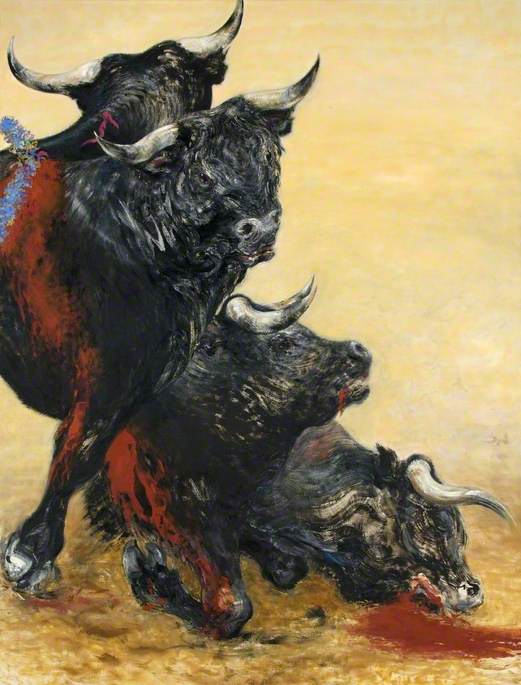 © the artist / Bridgeman Images. Image credit: Museum & Art Swindon
© the artist / Bridgeman Images. Image credit: Museum & Art Swindon
-
Girl with a Fig Leaf
Girl with a Fig Leaf 1947Although best known for his intense painted nude portraits, Freud began his career preferring to draw. His early drawings and etchings have strong outlines and deep shadows. When he began to paint, he, worked day and night to master this this new medium, Drawing did not underpin his paintings: he pursued drawing and painting as two very different ways of creating art.
This portrait shows the artist’s wife, Kitty. It was etched directly onto a copper plate at the Hotel Negre Coste in Provence. Kitty poses with a fig leaf which obscures much of her face. Although Freud denied any symbolism, the fig leaf carries connotations of both nudity and modesty.
Lucian Freud (1922–2011)
Etching on paper
H 30 x W 24 cm
Museum & Art Swindon
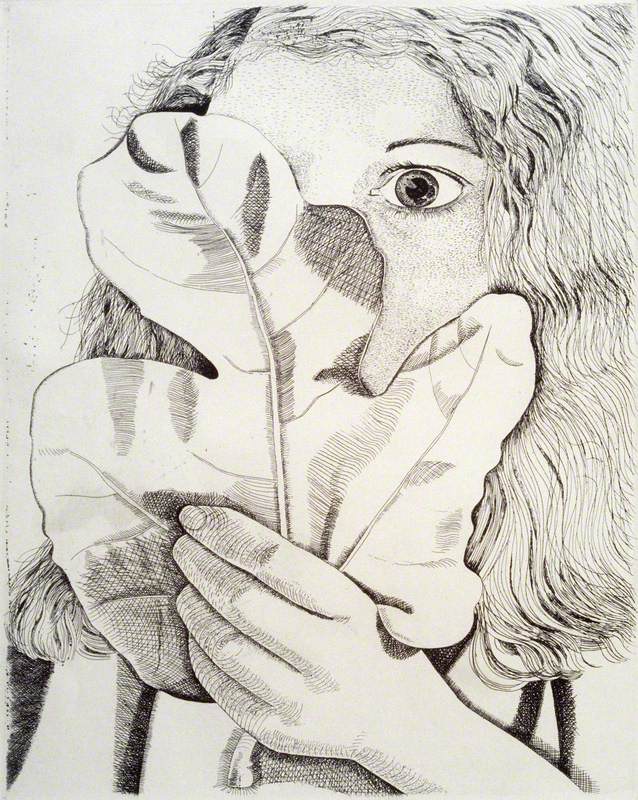 © Lucian Freud Archive / Bridgeman Images. Image credit: Museum & Art Swindon
© Lucian Freud Archive / Bridgeman Images. Image credit: Museum & Art Swindon
-
Ship Amid Tall Waves
Ship Amid Tall WavesThe St Ives artist Alfred Wallis is known for his portrayal of boats, often painted on sheets of old cardboard. Wallis was ‘discovered’ by Ben Nicholson and Christopher Wood, who also features in the Swindon Collection. They described Wallis as a “destitute, semi-literate Cornish fisherman” but admired his charming and direct style of working.
Wallis said, “I do most what used to Be, what we shall see no more”. This painting is a simple depiction of a small boat sailing through high waves. The sea is a thick layer of oil paint, but the details of the boat have been carefully drawn with pencil. The sky is unpainted, revealing the simple piece of cardboard underneath.
Alfred Wallis (1855–1942)
Oil & pencil on cardboard
H 26.5 x W 32.5 cm
Museum & Art Swindon
-
The Printer
The Printer c.1915Gosse was a talented printmaker and we can see this painting as partly autobiographical. Printmaking combined fine artistry with hard physical labour. As a female artist, Gosse was excluded from the Camden Town Group but became an important figure in the Royal Society of Painter-Etchers.
The painting shows a corner of Gosse’s own studio, complete with her heavy, green printing press which dominates the composition. The printer’s body echoes the curved line of the wheel, showing print maker and press working in unison to create the engravings hanging on the line behind.
Laura Sylvia Gosse (1881–1968)
Oil on canvas
H 100 x W 74.8 cm
Museum & Art Swindon
 © the artist's estate / Bridgeman Images. Image credit: Museum & Art Swindon
© the artist's estate / Bridgeman Images. Image credit: Museum & Art Swindon
-
The Thames
The Thames 1962Fedden painted this picture ‘from the garden wall, looking upstream to the island, Chiswick Eyot. It is high summer because angelica and cow parsley are out in the quay in June.'
Mary Fedden (1915–2012)
Oil on canvas
H 49.3 x W 59.5 cm
Museum & Art Swindon
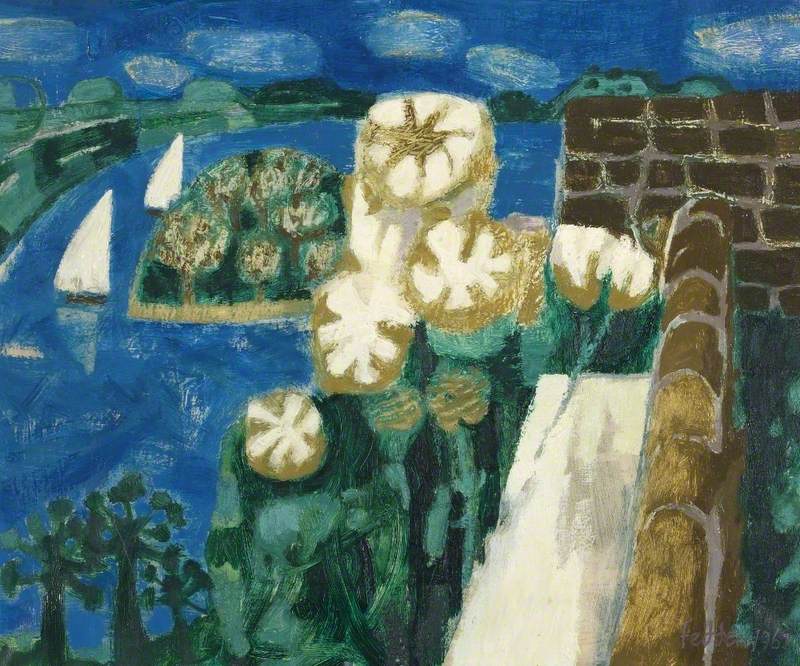 © the estate of Mary Fedden / Bridgeman Images. Image credit: Museum & Art Swindon
© the estate of Mary Fedden / Bridgeman Images. Image credit: Museum & Art Swindon
-
Birling Gap
Birling Gap 1981–1983When he first came across the cliffs at Beachy Head, Camp found them to be ‘shocking, a dream come true’. He and his wife Laetitia visited them in all weathers and at different times of day and night and they were never the same twice. This painting, one of his last in a series and made after a three year absence from painting and after parting from his wife, has a different mood from earlier clifftop paintings.
Jeffery Camp (1923–2020)
Oil on board
H 72 x W 122 cm
Museum & Art Swindon
-
Grey, Black and Red Verticals
Grey, Red and Black Verticals 1962This painting was made at an important stage in Frost’s career. The three curves at the top of the canvas were inspired by Rubens painting of three goddesses. The work is inspired by women, in Frost’s words, “perhaps from a time when woman ruled the world”. The smear of thin grey paint suggests a reclining figure, with the black verticals offering “rhythm and poetry”.
Terry Frost (1915–2003)
Oil on canvas
H 101 x W 126.5 cm
Museum & Art Swindon
-
The South East Corner, Jerusalem
The South East Corner, Jerusalem 1926Inspired by Roger Fry’s Post-Impressionist exhibitions, Bomberg developed a style of abstract painting, ‘stripped of irrelevancies’ and featuring brightly coloured, cuboid figures and dynamic compositions.
After the war Bomberg felt alienated from the art world and travelled to Jerusalem. He was inspired by the landscape to adopt a more painterly way of working which combined geographical accuracy, and rich, confident brush marks.
In this work, the blue dome of the Dome of the Rock can be seen towards the centre of the painting. The Wailing Wall is in shadow just beneath. Beneath the paintwork is a detailed and accurate drawing, which has allowed Bomberg to create his finished work with such bold simplicity.
David Bomberg (1890–1957)
Oil on board
H 55.5 x W 73.2 cm
Museum & Art Swindon
-
The Sibyl
The Sibyl 1964Sybils, the women prophets of Greek and Roman legend, frequently appeared in Collins’s paintings and prints. He recounted in an interview in 1979: ‘They [Sybils] seem to be visions of certain functions of the feminine soul – prophetic, oracular, sometimes coming out of caves, guardians of altars, uttering prophesies. They are, as it were, the voice of the unknown or entries into the unknown land, guarded in my paintings, I think seldom by a man but practically always, by a woman or an Angel’ (Cecil Collins, ‘Theatre of the Soul’, interviews, 27 September and 13 October 1979, Keeble, p.121).
Cecil Collins (1908–1989)
Oil & acrylic on board
H 75 x W 90 cm
Museum & Art Swindon
 © Tate / Tate Images. Image credit: Museum & Art Swindon
© Tate / Tate Images. Image credit: Museum & Art Swindon
-
Welsh Hills
Welsh HillsNevinson served in WWi as an Ambulance Driver and as a member of the Royal Army Medical Corps, before becoming an Official War Artist in 1917.
Most admired for his strong wartime paintings in the Vorticist/Futurist style, he abandoned this style after the war. He explored new subjects, including British landscapes.
the rays of light falling across the fitfully-lit cloudy landscape look back to his Vorticist period and give it an architectonic strength.
Christopher Richard Wynne Nevinson (1889–1946)
Oil on canvas
H 49.3 x W 59.5 cm
Museum & Art Swindon
-
Roman Window
Roman Window 1950Roman Window is painted from a hotel bed across the road from this room, and wonderfully described by Ayrton in an the essay from the collection 'Golden Sections' (published Methuen 1957). The painting involves mysterious communication and unspoken drama and is technically fascinating.
Michael Ayrton (1921–1975)
Oil on canvas
H 125.5 x W 75 cm
Museum & Art Swindon
-
Gramophone
Gramophone 1964–1966Hodgkin was a prolific painter and printmaker and he won the Turner Prize in 1985.
This painting offers insight into Hodgkin’s artistic process. The work appears abstract but shows the artist’s attempt to capture an entire moment in time. Here, he began with the subject of two friends in a room listening to music on a gramophone. Over two years, he added layers and layers of paint that emphasised the work’s musical quality while concealing specific detail.
Hodgkin’s paintings and prints are vivid, expressive and immediate. However, they came from a process of deep consideration and artistic development in which complex ideas and subjects are portrayed with colour and vibrancy.
Howard Hodgkin (1932–2017)
Oil on canvas
H 71.5 x W 91.5 cm
Museum & Art Swindon
-
Edge of the Wood
Edge of the Wood c.1944This painting was from a watercolour study. It was painted about 1944 at Madams, the Gloucestershire home of Nash’s friends, which became a war-time refuge for him. On his first visit to the house, Nash wrote to his wife “This is an enchanting place”.
The fluidity of the drawing and the delicacy and freshness of the colours do much to evoke the spirit both of spring and the place.
Paul Nash (1889–1946)
Pencil & watercolour on buff paper
H 38.7 x W 57.2 cm
Museum & Art Swindon
-
Still Life with Boats, St Ives, Cornwall
Still Life with Boats, St Ives, Cornwall 1930The theme of a window and landscape beyond was first used in British Art in the 1920s by Winifred Nicholson. Smeaton’s Pier is on the right with its small lighthouse, with St Ives Harbour on the extreme right. The fishing boats are painted in the style of Alfred Wallis (who Wood 'discovered' with Ben Nevinson) and sailing boats may well have gone out of use by 1930.
Christopher Wood (1901–1930)
Oil on panel
H 22 x W 53.5 cm
Museum & Art Swindon
-
Bright Intervals
Bright Intervals 1928After being injured during the war, Wadsworth designed camouflage for ‘dazzle ships’. A number of artists created complex geometric coloured patterns for naval ships, which made it harder for enemy craft to estimate speed and distance. This experience of combining patterns and marine forms to distort perception would influence his later art.
Bright Intervals, also known as ‘Song of the Sea’ or ‘Dunkirk: Barometer, Wool and Floats’ is a highly formal still life. The group of objects, including a shell, fishing floats and a blueprint, have been painted with precision and control. However, the seascape in the background is entirely imaginary.
Edward Alexander Wadsworth (1889–1949)
Tempera on canvas laid on panel
H 63 x W 88 cm
Museum & Art Swindon
Explore artists in this Curation
View all 28-
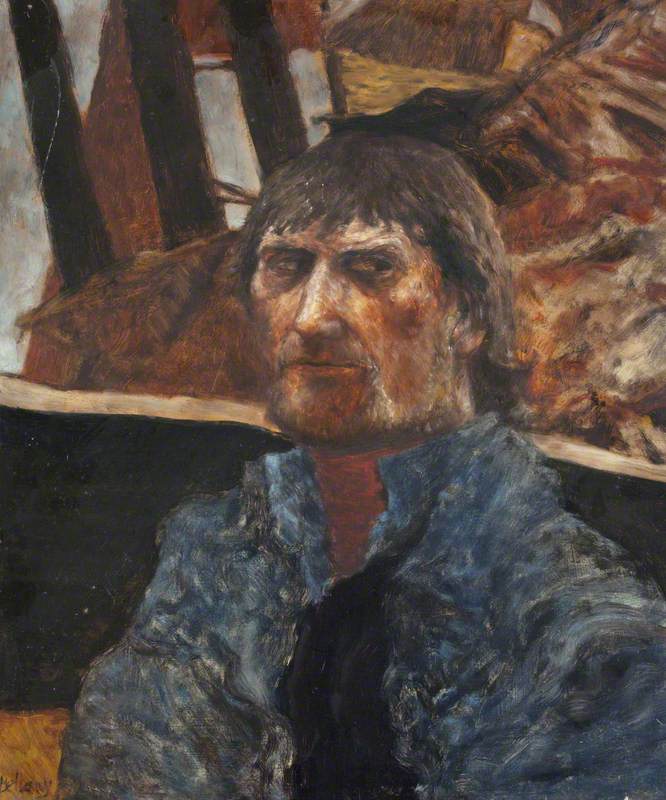 John Bellany (1942–2013)
John Bellany (1942–2013) -
 Laura Sylvia Gosse (1881–1968)
Laura Sylvia Gosse (1881–1968) -
 Terry Frost (1915–2003)
Terry Frost (1915–2003) -
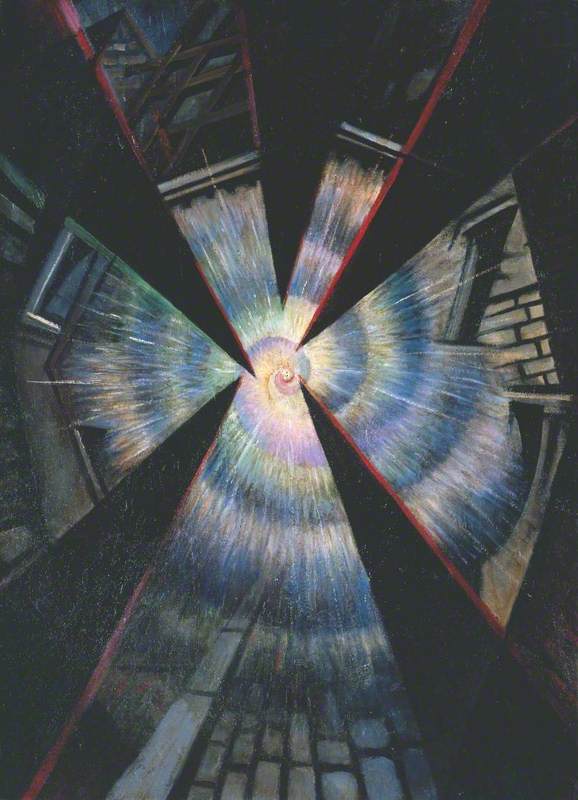 Christopher Richard Wynne Nevinson (1889–1946)
Christopher Richard Wynne Nevinson (1889–1946) -
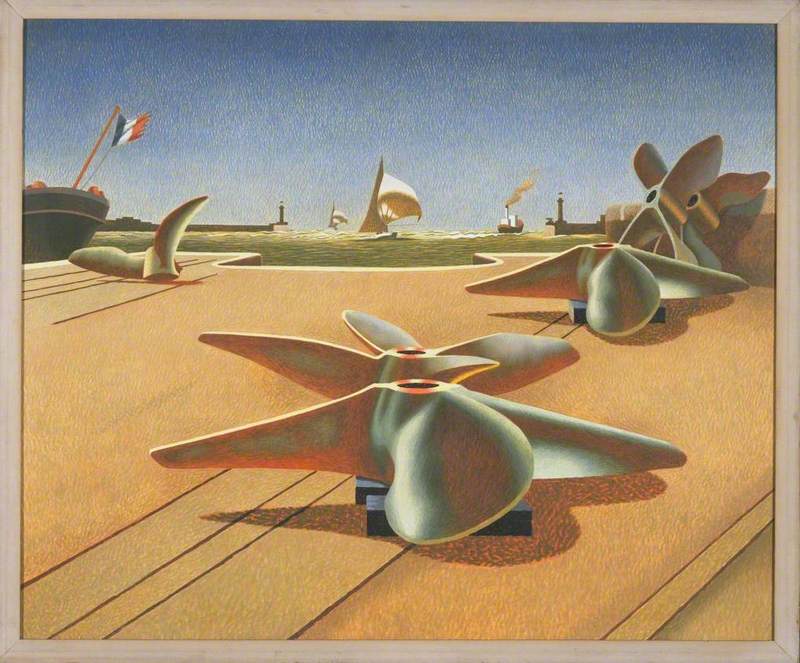 Edward Alexander Wadsworth (1889–1949)
Edward Alexander Wadsworth (1889–1949) -
 Ivon Hitchens (1893–1979)
Ivon Hitchens (1893–1979) -
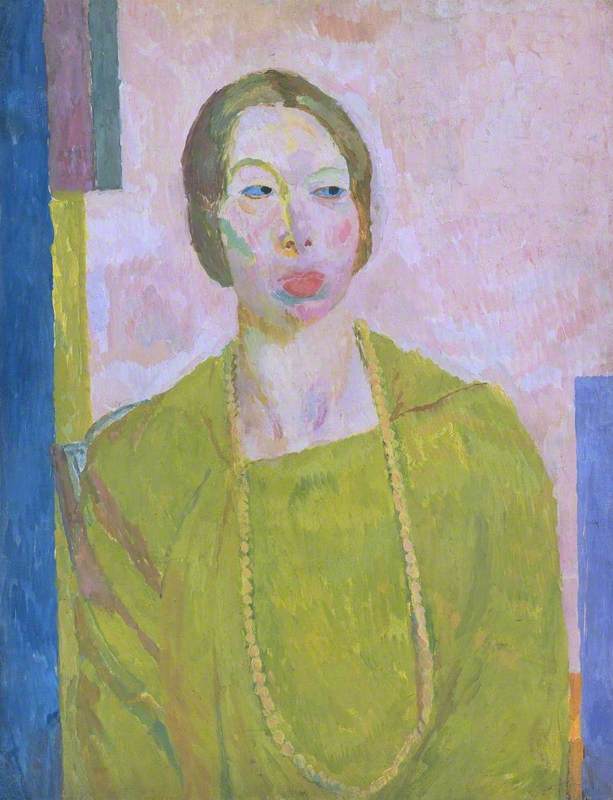 Vanessa Bell (1879–1961)
Vanessa Bell (1879–1961) -
 Mary Fedden (1915–2012)
Mary Fedden (1915–2012) -
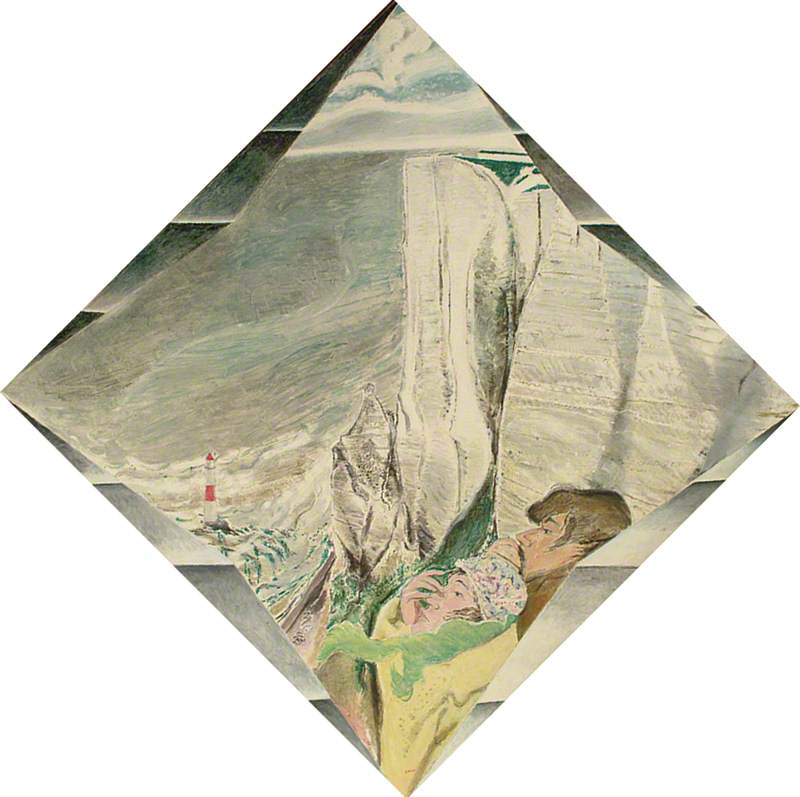 Jeffery Camp (1923–2020)
Jeffery Camp (1923–2020) -
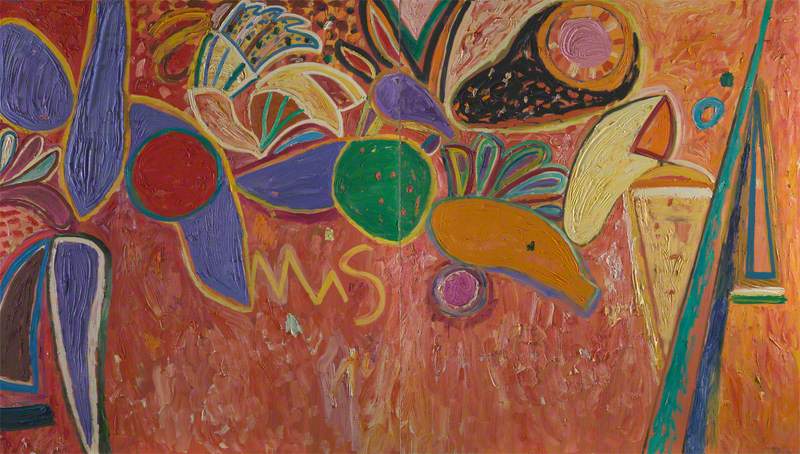 Gillian Ayres (1930–2018)
Gillian Ayres (1930–2018) - View all 28
